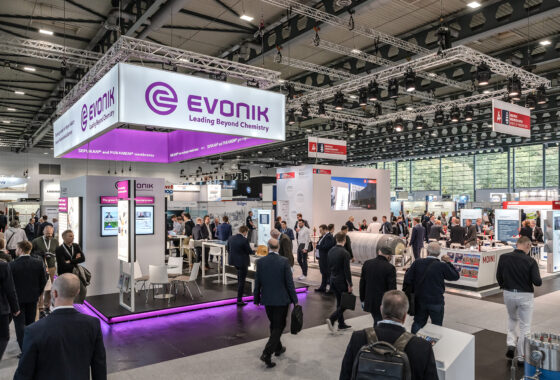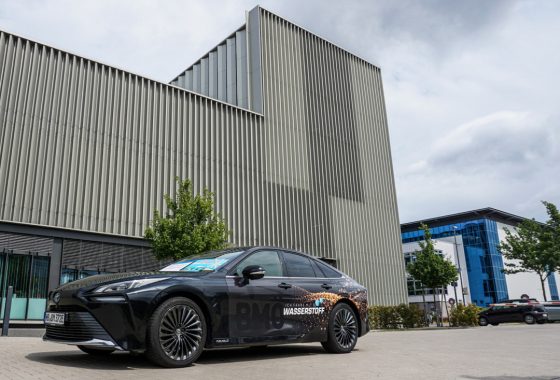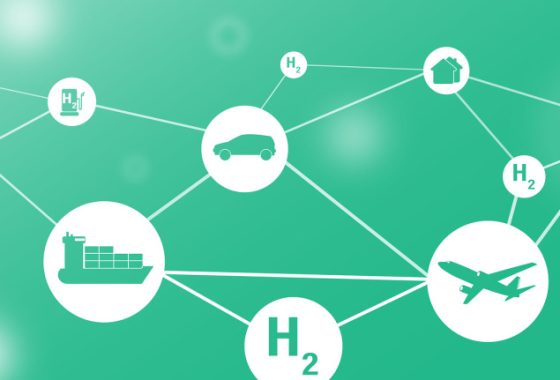
Carbon-neutral hydrogen is an essential element of our future energy supply arrangements. In the Federal State of Bremen, more than a billion Euros are currently being invested in sustainable hydrogen projects. This article provides an overview of the City of Bremen's hydrogen initiatives.
Bremerhaven is also a location for renewable energy and the hydrogen industry, besides the City of Bremen. The many Bremerhaven initiatives and projects are also presented on the BIS Bremerhaven website. (BIS Bremerhaven is the Bremerhaven investment support and city development organisation.)
You will find additional information about hydrogen-related issues, contact details for people involved with them and relevant events on the Bremen Hydrogen Office web page.
Stakeholders in hydrogen projects in the city of Bremen:

EVIA AERO is the first airline to operate hydrogen-powered aircraft, Image: EVIA AERO
Company/Institute
- Airbus and the "Zero Emission development Centre" ZEDC
With "ZEROe" as its slogan, Airbus is currently developing climate-neutral aircraft which will be ready for series production before 2035. To bring together expertise in the field of hydrogen, the Airbus group has set up two Zero Emission Development Centres (ZEDCs), one in Nantes in France and one in Bremen. The aim of these ZEDCs is to develop hydrogen tank systems for commercial aviation. In this respect, the Bremen Airbus plant benefits from its proximity to the ECOMAT research centre in Airport City (the headquarters of the Bremen group is only a few minutes away by foot). - EDAG
This automobile components supplier has a development and production site in Bremen. The company has also brought together part of its hydrogen-related activities here. In 2018, the hydrogen-powered Mercedes GLC F-Cell vehicle went into small-scale production. Today, EDAG is working on expanding its expertise in this field with the objective of manufacturing in greater numbers. For example, EDAG designs and builds tank systems for many famous manufacturers that plan to add hydrogen drives to their product portfolio. - Enginius
This subsidiary of FAUN, the commercial vehicle manufacturer, is producing hydrogen-powered lorries in Bremen. The first product it brought to market was a dustbin lorry and the company is currently manufacturing other models for regional haulage purposes and special local authority use. The chassis for these vehicles come from major lorry manufacturers. These chassis are then converted, extended and fitted with hydrogen drive technology in Bremen, before receiving their special EU type approval. - EVIA AERO
The first German airline to fly using hydrogen – that's EVIA AERO's achievement. This young company aims to operate in regional aviation and fly to a range of destinations in Northern Europe, using hydrogen-powered aircraft based on the Britten-Norman Islander model. In addition to the 15 aircraft of this type, the company has also ordered 10 more 19-seater planes from Cranfield Aerospace Solutions. - SAACKE
This Bremen-based burner installation and boiler systems manufacturer is the "go-to" component supplier for the hydrogen sector. The company supplied a gas combustion unit and a hydrogen burner for the world's first liquid hydrogen tanker, the Japanese "Suiso Frontier", ensuring safety on board.The company is also active in the automobile industry. - Scandiesel
The Bremen general importer Scandiesel specialises in marine engines and industrial motors. Up to now, its engines have primarily been driven by diesel. However, this may well change in the coming decades. Methanol, produced from hydrogen, is a possible candidate to replace the diesel used in heavy industry. Scandiesel supplies the motors used in this sector and has already been involved in a research project on the first methanol-powered ship in Germany – the Uthörn 2, which is operated by the AWI (the Alfred Wegener Institute). An entire value creation chain is currently developing around and about this ship, involving participants in Bremen and Bremerhaven. For example, it uses local methanol-based tank and bunker technology and, in future, will also involve the production of green methanol. - ArianeGroup and OHB aerospace groups
The two heavyweights, ArianeGroup and OHB, are an important element of the Bremen H2 network. This is because they already have decades of experience in the commercial use of hydrogen, even though it's been to power for rockets and the fuel cells used in satellites. For more than 40 years, the ArianeGroup in Bremen has been a trailblazer for the use of hydrogen in aeronautics. The upper stages of the ARIANE 5 and 6 launch vehicles were powered by cryogenic liquid hydrogen. The experiences gained from this expertise in systems, added to the increase in performance of ARIANE's upper stage, are now being put to good use in the rapid development of emission-free aviation. A number of cooperative ventures, driven forward by a partnership involving Airbus, DLR, IFAM and FIBRE, in Bremen, are currently working on developing cryogenic hydrogen tanks made from fibre composite materials. These projects make effective use of the powerful synergies they create between application areas in the aviation and aeronautics industries, and result in even greater efficiencies in the materials used. Also closely connected with these activities is OHB, the Bremen-based aerospace group, whose subsidiary, MT Aerospace, manufactures systems and modules for launch vehicles, space vehicles and satellites. The company is currently working on tank systems, among other things, with the Ariane group, which has overall organisational management responsibility. The expertise in hydrogen application of Bremen's aerospace network is now becoming important for aviation. - ArcelorMittal
Hydrogen has been used in steel manufacturing for quite some time. For example, the Bremen ArcelorMittal steel plant is already using grey hydrogen, among other things as an inert gas, and is the largest user of hydrogen in the Federal State of Bremen. To prepare for the future, the company is now working on also using green hydrogen and is involved in a range of projects with this goal in mind (see below). - swb
swb, the Bremen-based energy supplier, working together with the company INGAVER Innovative Gasverwertungs-GmbH, is especially closely involved in providing power for the ArcelorMittal steel plant in Bremen and therefore also in the future supply of hydrogen. One of its primary objectives is the construction and operation of large-scale electrolysers (see also Projects). - Bremen's scientific environment
Universities, technical universities and institutes: a wealth of people in Bremen's scientific communities are actively involved with hydrogen. For example, the City University of Applied Sciences has study courses and applied research that are involved in many aspects of hydrogen. It has close links to many major companies and participates in the ECOMAT technology centre. The University uses its technical expertise in its involvement with the green hydrogen value creation chain: Practical research projects and study courses cover almost every imaginable aspect of "hydrogen", from H2 electrolysis, transport, port logistics and infrastructure to applications such as aviation, aerospace or maritime transport, through to commercial, ecological life cycle and sociological sustainability analyses. Scientists taking a range of degree courses, working in the specialist areas of environmental and energy technology, aviation and aerospace, ship-building, nautical science, logistics, politics and social sciences, electrical power and control engineering, computer science/AI or economics help the specialist staff of the future to gain insights into areas in which H2 can be used during their degree courses and work together with industrial partners to discover solutions for the H2 economy.
ECOMAT is an inter-disciplinary research centre with the focus on carbon-neutral flight. It brings together a multitude of Bremen's areas of expertise, from aviation and aerospace, material sciences and IT technology and has a workforce of around 500 scientists. When it comes to hydrogen, research into, and the development of, hydrogen tank systems and new materials for aviation play central roles at ECOMAT.
Its partners include many of Bremen's scientific institutes such as:
- BIAS – Bremen Institute for Applied Beam Technology
- German Aerospace Center
- Faserinstitut Bremen e.V. (FIBRE)
- Fraunhofer Institute for Manufacturing Technology and Advanced Materials IFAM
- Foundation Institute of Materials Engineering - IWT
are represented at ECOMAT with their hydrogen research endeavours and are also involved with their own projects.
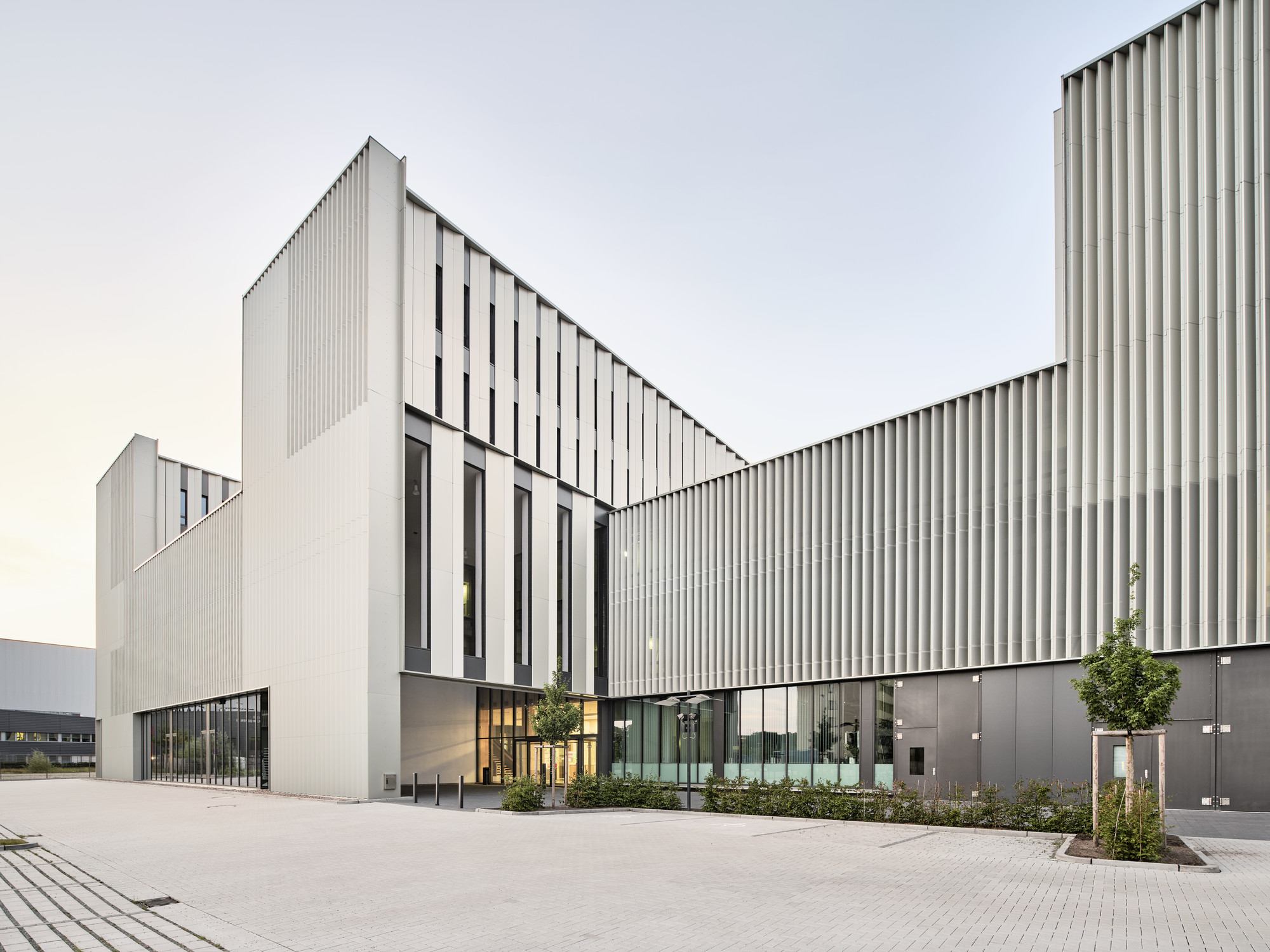
The ECOMAT research center is one of the focal points of Bremen's hydrogen activities, Photo: WFB/Sessler
Hydrogen in Bremen: Large-scale projects
A wealth of research and industrial projects are associated with research into this climate-friendly gas. We have summarized the most important of them below:
- Hybit – Hydrogen for Bremen's Industrial Transformation
With over 20 million Euros investment, Hybit not only aims to prove the feasibility of a large-scale industrial infrastructure, based on green hydrogen, but also make a start on implementing it. To achieve this, 10 megawatts of electrolyser capacity is currently under construction at the Mittelbühren power plant, which will come online in 2024. The power plant produces hydrogen for the ArcelorMittal steel plant in Bremen, where it is used as both in the production of climate-neutral steel and also for mobility, for example, in logistics. The project is being run by the EWE and swb power suppliers and ArcelorMittal Bremen. - hybit – Hydrogen for Bremen's Industrial Transformation
This scientific project is managed by Bremen University and is being supported by 30 million Euros from the German Federal Ministry of Education and Research. Its activities complement those performed at the steel plant and also includes the industrial port and cargo-handling centre in its remit. The research aims to discover how hydrogen can be used, in interaction with different sectors, above and beyond the steel plant and how it can be used, for example, to resolve ecological and social issues and challenges alongside those from the worlds of economic feasibility and technology. - DRIBE2
The steel plant is also home to the DRIBE2 project. The project came about as part of the IPCEI, the Important Project of Common European Interest, which promotes the use of hydrogen throughout the continent of Europe. Thanks to input from the ArcelorMittal Plant in Eisenhüttenstadt, a direct reduction plant has been constructed in Bremen. It uses gas to process iron ore. Coal or coking coal is no longer required. If hydrogen – as created by the first step in the Hybit project – is then used as the operating gas, the iron ore can be transformed into steel at no detriment to the environment. - Hyways for Future
Around 90 million Euros of investment, of which 20 million Euros have come from the German Federal Government, have flowed into Hyways for Future. This project, in the North-West German metropolitan region, aims to promote the use of hydrogen in the mobility sector. To achieve this, it's investing in building hydrogen filling stations and procuring hydrogen-powered buses for the local public transport network, bin lorries and hydrogen-driven cars and trucks. The aim is to create an offer and the demand for what is on offer at the same time. - Clean Hydrogen Coastline
Before hydrogen can be used as a source of energy, it needs producers, consumers, transport routes and storage facilities. This is a complex system and the interactions between its component parts must first be thoroughly investigated. For that very reason, the Clean Hydrogen Coastline project is using the existing North German infrastructure to look into how these component parts interact with each other so that it can set actual capacities. For example, electrolyser capacities of several 100 megawatts are being built, storage options are being investigated, hydrogen filling stations are being constructed and a pipeline distribution network is being extended. The project takes into account consumers that are associated partners, such as the steel plant in Bremen or Enginius, the vehicle manufacturer, and its customers. - WOPLiN
The WOPLiN-Project ("hydrogen development and production for aviation") is closely associated with Airbus's plans to put a climate-neutral airplane in the air before 2035. The Bremen components of WOPLiN are the Zero Emission Development Centre (ZEDC), which is working on the pre-industrial stages of tank systems for liquid hydrogen, and the Fire Safety Certification Center (FSCC). The research project aims to enable the use of liquid hydrogen in the aviation industry and create the basis for a "zero emissions" airplane. This is an endeavour that takes into account the options for installing tank systems in airplanes and industrial production processes. - HyPerLink
If you want to transport large volumes of hydrogen, you need pipelines. In its HyPerLink project, the company Gasunie aims to build 610 kilometres of hydrogen network infrastructure in Northern Germany. To achieve this, the company intends to use existing natural gas pipelines and storage facilities and plans to link the Nüttermoor energy store on the border with the Netherlands with Bremen and Hamburg by 2025. The project is closely connected with the Clean Hydrogen Coastline project. - ITZ Nord
Across Germany, four Innovation and Technology Centres (ITZs) involved with hydrogen are promoting the use of this technology in the transport sector. One of these is in the North: ITZ Nord. It is spread over four cities, Bremen, Bremerhaven, Hamburg and Stade, with the intention of providing services for the aviation and shipping industries.
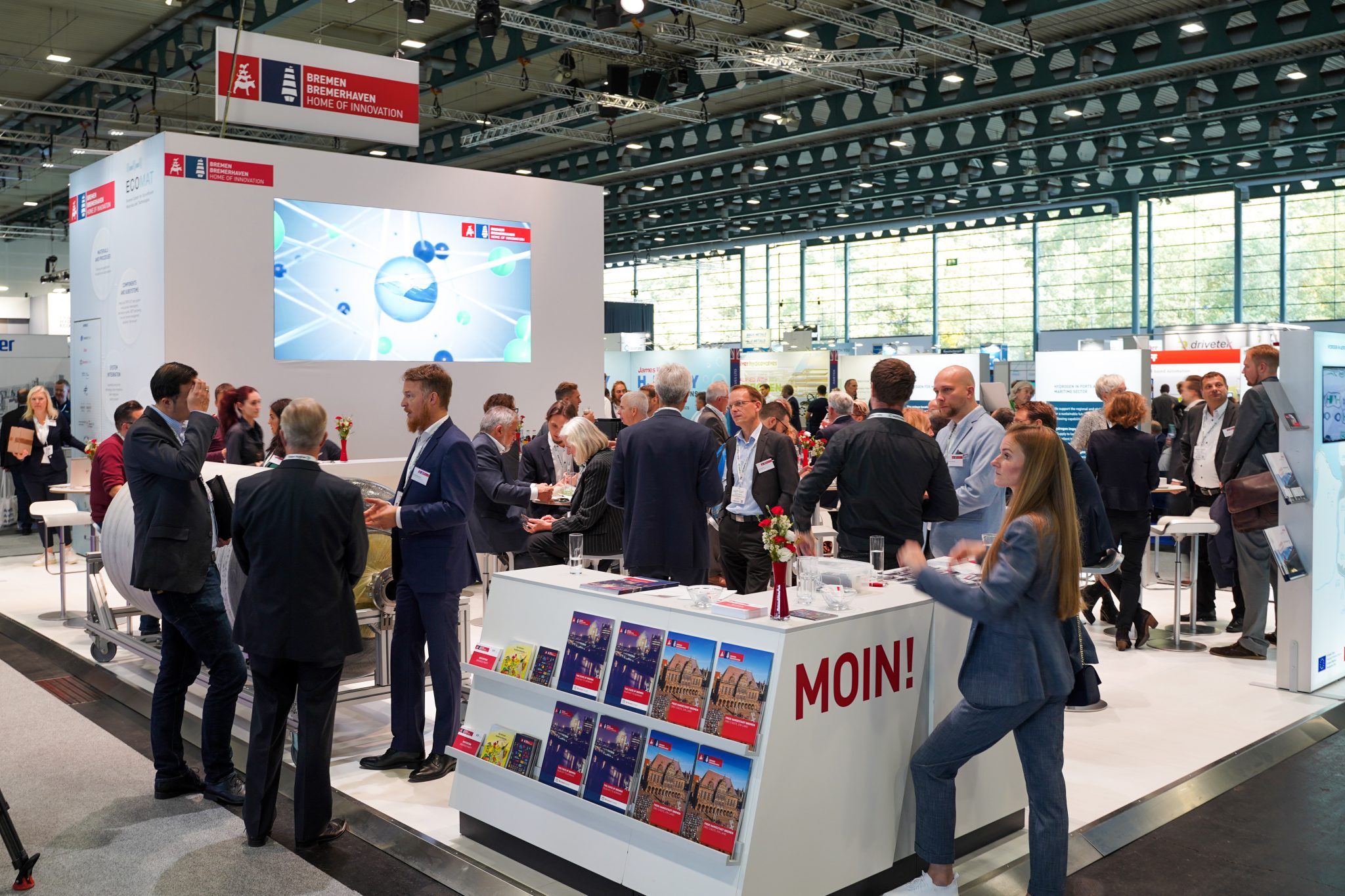
The state of Bremen presented itself at the Hydrogen Technology Expo, Photo: WFB/Raveling
Hydrogen in Bremen: Initiatives
- HY-5
The aim of this initiative is to promote the North as a site for hydrogen, bringing together the business development offices of the five North German Federal States. With this purpose in mind, the institutions will appear together at trade fairs at home and abroad, use podcasts (https://germanyworks.com/webinars/hy-5) to provide information about the sites and network their activities in the knowledge that the transition to carbon-neutral hydrogen requires inter-state cooperation within Germany. - Bremen's hydrogen strategy
The strategy agreed in 2021 has set the course for the future up to 2025 and 2030. In this strategy, among other things, Bremen undertakes to expand the hydrogen infrastructure and promote a plethora of projects in the industrial, transport and energy sectors. It is embedded in the North German hydrogen strategy and the hydrogen strategy of the North-West German metropolitan region. In December 2021, the "Climate protection strategy for the state of Bremen" fact-finding commission presented its final report and stated its objective of achieving climate neutrality for the Federal State of Bremen before 2038. To make this aim a reality, the hydrogen produced using renewable energy, and the products derived from it, will be used in areas where renewable electricity is unable to replace natural gas and petroleum. - North German Hydrogen Strategy
In 2019, the German Federal States of Bremen, Hamburg, Mecklenburg-Western Pomerania, Lower Saxony and Schleswig-Holstein agreed to the North German Hydrogen Strategy and are working together to implement its measures. The outward-facing aspects of this strategy can be seen in joint initiatives at German Bundesrat (Federal Council) level or in the way the Federal States work together when dealing with the German Government. The strategy's internal aspects include applying commonly-agreed approaches to a variety of different areas of activity. - Hydrogen Technology Conference & Expo Europe
The world's largest trade fair for suppliers involved with hydrogen takes place in Bremen in Autumn every year. In 2023, it is already planned for September. More than 350 exhibitors will be ready to welcome the 5,000 or so visitors to the event. The trade fair will be accompanied by a conference programme with distinguished guests from all over the world and well-known manufacturers and users of hydrogen technology. - International networking
Just as networking with other hydrogen projects in Germany is an important step towards creating a hydrogen infrastructure, the same is equally true for networking on the international stage. For this reason, Bremen is working with other countries at many other levels: commercial, scientific and by exchanging knowledge and expertise with institutions. Bremen is in close contact with Nantes in France, Norway, Groningen in the Netherlands and even Tasmania. - Inter-disciplinary cooperation
In future, hydrogen will be used in many industrial sectors. For this reason, it is vital to create links with relevant organisations as early as possible. To achieve this, Bremen's organisations and associations, such as Aviaspace (aviation), MCN (maritime), WAB (wind power), Automotive Nordwest and H2BX (hydrogen) are working closely with each other, and also with the Wasserstoffgeschäftstelle Bremen (Bremen Hydrogen Office), the business sector and other stakeholders from the worlds of science and research, politics and associations, chambers of commerce and other organisations, to name but a few.
This list of projects and stakeholders is merely intended to provide an initial overview and, given the dynamic environment, must not be considered definitive. Do not hesitate to contact us if you're running a project that involves hydrogen, or if your company or institute is able to offer expertise in this area.
Older News
Contact
Hydrogen Office
For all inquiries regarding hydrogen in the state of Bremen
Elitsa Pesina
Policy Officer, Hydrogen Office
T +49 (0) 421 361-32293
elitsa.pesina@wae.bremen.de


